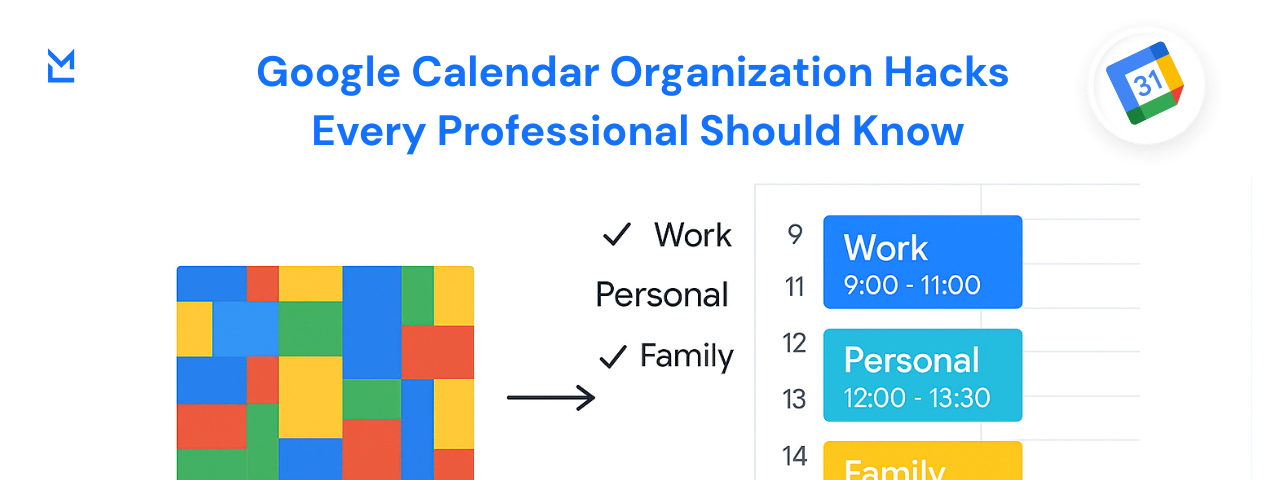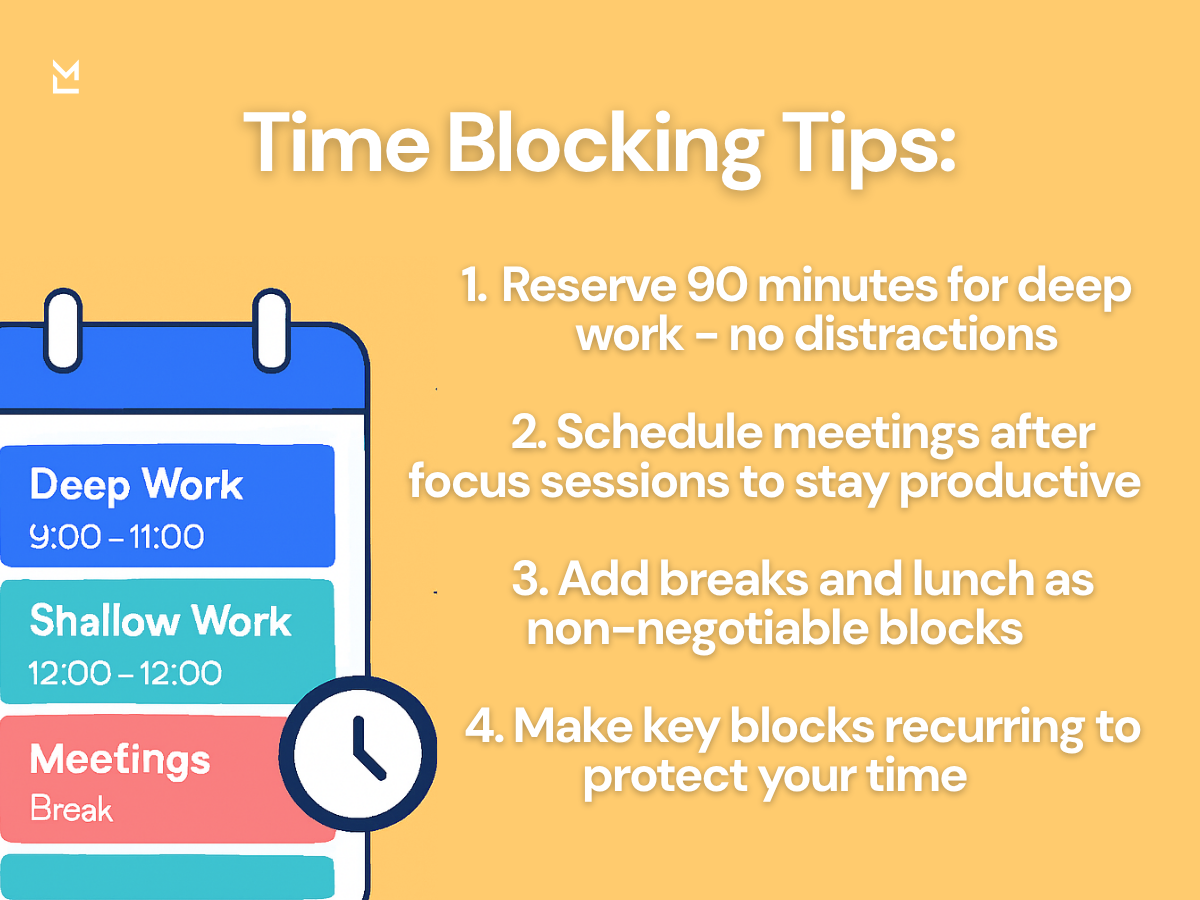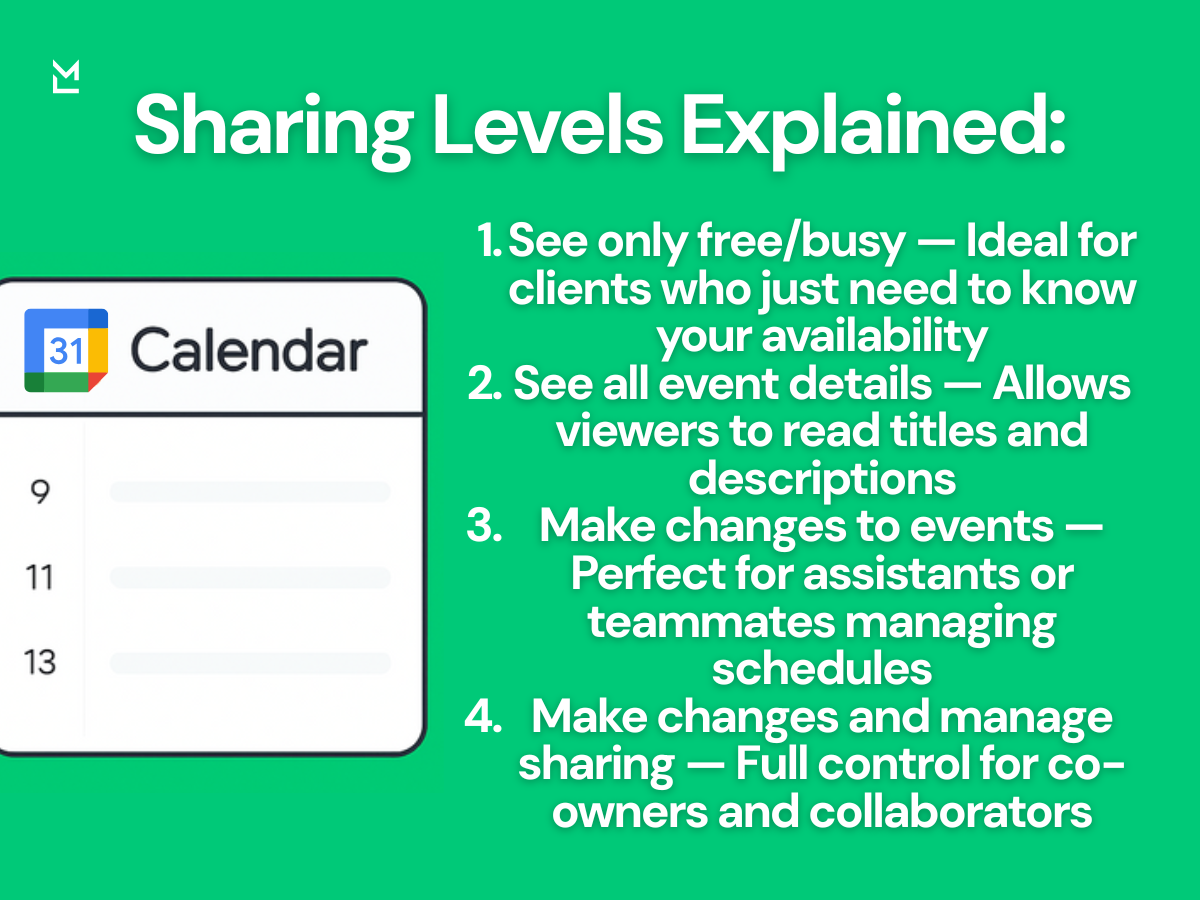
Written with help from MinutesLink - free AI meeting notetaker for online meetings.
Written with support from MinutesLink — a free AI notetaker for online meetings.
One of the most overlooked features of Google Calendar is the ability to create multiple calendars. Many people try to cram their life into a single calendar, which quickly becomes chaotic. By separating your calendars into categories, you gain clarity and focus.
Imagine your week as a collection of boxes: work projects, personal appointments, family events, fitness routines, and learning or development tasks. Stuffing all of them into one calendar creates visual noise and makes it hard to focus.

By creating separate calendars, you can toggle their visibility, reducing clutter. Suddenly, your work week is clear, your personal life is manageable, and your family schedule is visible without overwhelming your mind.
Example: Emily, a freelance designer, divided her calendar into three main areas: clients, personal life, and wellness. She found she could now glance at her schedule and immediately know where her time went without feeling overwhelmed.
Creating new calendars is simple:
Color-coding is incredibly powerful. A quick glance can tell you whether an event is work-related, personal, or urgent. For example, blue for work, green for personal, yellow for family, and red for deadlines.
Mini tip: Use a Google Sheets calendar template to map out your color-coded events for a week or month in advance. This can make planning much easier and give you a big-picture view.
Even with multiple calendars, your productivity can plateau if you don’t manage your time intentionally. Time blocking is the strategy of assigning specific periods for each task or activity.

Instead of a traditional to-do list, time blocking schedules everything - deep work sessions, meetings, email checks, breaks, and personal time. It creates structure and ensures your highest-priority tasks get dedicated attention.
Example: Tom, a project manager, blocked his mornings for deep work and afternoons for meetings. Within one week, he noticed he was completing twice as many high-priority tasks and felt less stress.
Pro tip: Make blocks recurring events to protect your schedule consistently. For example, a daily 90-minute focus session for project work.
Exercise for the reader: Look at your calendar now. Identify 2–3 hours this week you can dedicate to deep work and mark them as non-negotiable.
Many tasks are repetitive. Adding them manually wastes time. Google Calendar’s recurring events feature allows you to automate your schedule and build consistent habits.
Recurring events can include:
Tip: Pair new habits with existing ones using habit stacking. For instance, schedule “Morning Coffee & Plan Day” to ensure daily planning becomes automatic.
Example: Jenny stacked a 10-minute meditation before reviewing her tasks each morning. Within a month, her focus and productivity improved dramatically.
Coordinating schedules with teams or family can be chaotic without sharing. The share Google Calendar feature improves transparency and collaboration.

Example: A small design agency shared team calendars for projects, deadlines, and vacation days. Email chains dropped dramatically, and everyone stayed aligned.
Your calendar can do more than track events - it can manage all your tasks and reminders.
Tip: Dedicate a block to work on tasks. Use drag-and-drop to adjust priorities as needed.
Example: Sophia schedules a 30-minute morning block for task completion. Her completion rate of top priorities jumps to 80% daily.
Sometimes, you need a macro-level view of your schedule. A Google Sheets calendar template with multiple sheets is ideal for planning projects, tracking hours, budgets, and deadlines.
Example: Alex, a freelancer, manages several clients with a Google Sheets calendar template. Tasks, deadlines, and hours are tracked in one file, streamlining workflow.
Sharing is simple. Invite team members to update progress in real time. This makes your spreadsheet collaborative and dynamic.
Google Calendar integrates with various productivity tools and apps to increase efficiency.
Tools like Trello, Asana, Zapier, or IFTTT can sync deadlines, track projects, and automatically update Google Sheets calendar templates.
Tip: Pick one app to integrate today and notice the immediate time saved.
Learning the tools is one thing, but mastering productivity requires time management training. These courses teach strategies for overcoming procrastination, structuring your day, and maintaining focus.

Mini story: Liam took a 4-week online course and learned how to optimize recurring events, block deep work time, and integrate productivity tools. Within a month, he doubled his output while reducing stress.
Your ultimate aim is a calendar you trust completely. Whether it’s color-coded events, Google Tasks, or a Google Sheets calendar template, centralizing everything in one place frees mental space. You can focus on meaningful work instead of juggling tasks in your head.
There’s no single “right” way to organize a calendar, and that’s the beauty of it. Start small by trying one or two organization hacks, like creating multiple calendars for work, personal life, and projects, or implementing time blocking for focused work sessions. Once you feel comfortable, layer in recurring events, share calendars with teammates or family for smoother collaboration, and experiment with a Google Sheets calendar template for advanced planning. The goal is simple: a schedule that is clear, manageable, and adaptable to your life. Investing even a little time now in setting up your calendar will save hours of mental energy in the future, reduce stress, and help you stay consistently productive. Ultimately, your calendar should serve you - freeing up your mind so you can focus on what truly matters, achieve your goals, and take control of your life.
Sharing your Google Calendar is simple and extremely useful for teamwork or family coordination. On the desktop version, go to Settings > Calendars > Share with specific people, enter the email addresses, and select the level of access: view only, edit events, or full control. On mobile, open your calendar, tap the three dots next to a calendar, select Settings and Sharing, and follow the same steps. Sharing your calendar saves time, avoids scheduling conflicts, and keeps everyone aligned.
Choosing productivity tools starts with identifying your needs: task management, project tracking, scheduling, or automation. Popular options include Google Calendar, Google Sheets, Trello, Asana, and Zapier. Once selected, integrate these tools into your workflow by syncing deadlines, automating repetitive tasks, and tracking progress. The key is to start simple, test what works, and gradually layer in additional tools to enhance efficiency without creating overwhelm.
Yes! Google Sheets offers several calendar templates, accessible via Google Sheets > Template Gallery > Calendars. You can use them to track projects, deadlines, or personal schedules. A Google Sheets calendar template is highly customizable—you can add columns for tasks, hours, status, or links, and even create multiple sheets for different projects or months. This makes it an ideal tool for professionals who need more control than a standard Google Calendar offers.
Time management training teaches strategies to plan, prioritize, and execute tasks effectively. It includes methods like time blocking, task batching, goal setting, and prioritization frameworks. Such training helps reduce procrastination, increase focus, and improve productivity. Many courses are available online, ranging from short tutorials to comprehensive subscription programs. Professionals who invest in time management training often report lower stress and higher output.
Keeping track of tasks at work is essential for productivity and stress-free time management. Start by listing all your tasks in one central tool, like Google Tasks, a Google Sheets calendar template, or a project management app such as Trello or Asana. Use time blocking in Google Calendar to dedicate specific hours to high-priority work and recurring events to handle routine tasks automatically. Color-coding tasks and setting reminders ensures nothing gets lost, while integrating productivity tools can streamline your workflow. Regularly reviewing and updating your task list helps you stay focused, manage deadlines, and achieve your goals efficiently.